Our AfroMexican Ancestry runs deep and traces of our African Ancestry can still be seen today. My mother has always had very thick curly hair and my brother also has it the same way. Before you start judging me let me explain a little more. My tio (uncle) Chema passed away a few years ago. He had very dark skin and very curly hair. My other uncles did not have dark skin as he did but did have curly or wavy hair including my aunts. You may say that I am stereotyping him/them due to some traits and to be honest I was.
I used to tell my mom that we were black and she would just ask “Why do you think that?” I would tell her “just look at tio Chema”. She would quickly scold me and tell me not to say such things, that the family would get offended. Then I would tell her either we have black blood in us or Guela (grandma) had an affair with a black guy. As you can imagine she did not find my reasoning amusing.
Clues to my AfroMexican Ancestry
My first clue came with Galindo’s dissertation “Con Un Pie En Cada Lado: Ethnicities and the Archaeology of Spanish Colonial Ranching Communities Along the Lower Río Grande Valley” on Pg. 68 Table 5 she talks about there being 113 Afromestizos in the baptismal records of Ciudad Mier from 1767 to 1789. I thought to my self, “Mier is not that far from the ranch I grew up at”.
The second clue that I found to our Afro-Mexican ancestry was the marriage record of my 5th great-grandparents Joseph Antonio Tanguma and Maria Barbara Rodriguez. I have not posted online that document due to it being damaged and torn but even like that you can see the words “Antonio Tanguma morisco [torn] años Cirviente leal”. The first time I wondered what this meant after much research I found the following Casta Painting depicting the racial classifications and it tells us exactly what a Morisco is.
Our AfroMexican Ancestry
Mexican caste system drawing.
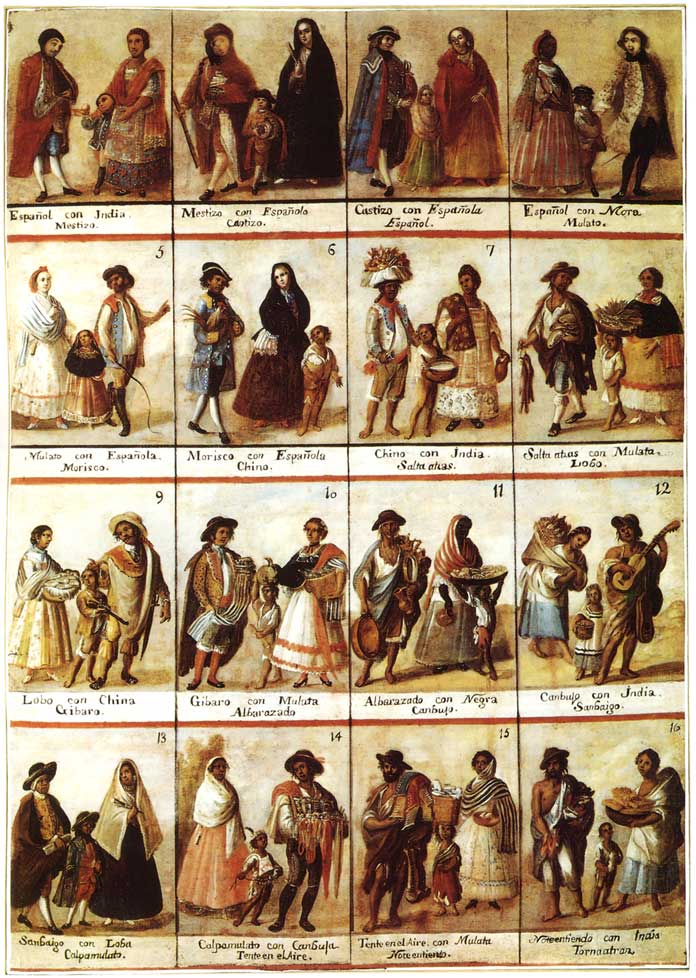
As you can see his father was a Mulato and married an Espanola.
“Cirviente Leal” (Faithful Servant)
When I read the names of other ancestors in the Mier 1757 census their names are listed and then goes on to say “todas armas” (all weapons) the number of children that they had, and finally number of servants. He was probably counted as a servant since his name is not mentioned. Years later in 1797, I do find him in the Mier Church Padrones listed as living on the ranch named Miguel Perez. He and his wife are listed as the oldest residents of the ranch. I wonder if he was a slave or just trying to make a living as a servant. I also wondered how society might have treated him. If you have more information about this ranch “Miguel Perez” or where it was or is located please let me know. I would love to find out who originally owned it since this will give me clues as to where to search for my ancestor. I still have yet to find the names of the parents of my Morisco ancestor.
My DNA Results
A driving force to doing my DNA test was to confirm that I had African ancestry and my AncestryDNA results confirmed it. It came back as 2% with traces to North Africa and Nigeria. Some people may not take this as being that significant but as Ancestry explains you are passed down DNA from many ancestors but not all. They also go on to explain in their videos that the DNA makeup of you and your siblings are different and for you to not be surprised if you have slightly different DNA results. Now I am just wondering, If I do a DNA test on my brother would his percentage come up higher?
Short Video about Afro-Mexicans
This video is very informative and you will get a quick background history of Afro-Mexicans.
Do you have African Ancestors?
If you do let me know, I would love to find out more about our African roots.
The Slaves of Monterrey
This book is an awesome resource and proves that the records are out there to prove that blacks were in Mexico and they never left, their blood, our ancestor’s blood, still flows through us. I hope that you embrace your ancestors and not alienate them. If you read the comments on YouTube under the above video you can see that people still have a long way to go when it comes to race.
Let me know what you think about this post and if you have anything to add to this post please post it in the comments section. FYI my Morisco ancestors are just one of many that I have found but I have to yet prove my ancestry to them with documents and thus that is why I don’t list them in this post. From my research, I have also come to find many ancestors labeled Mulatos and Mestizos.

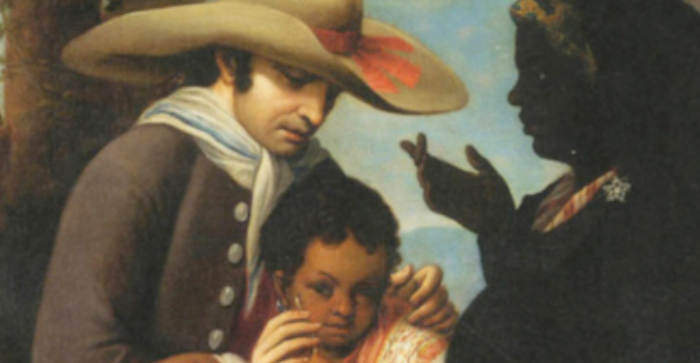

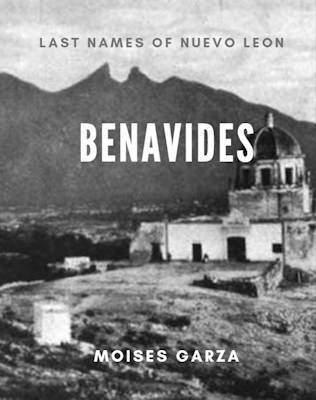

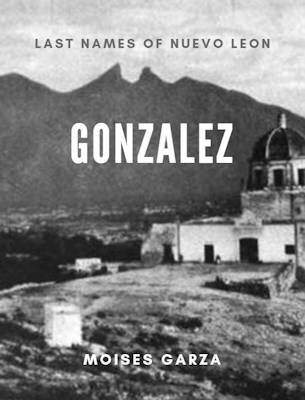
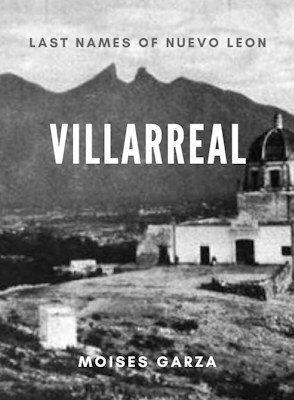

Mexican Americans are a rich mixture of many races.
We sure are, as I said on a Facebook comment “We area caldo of many ingredients”.
Have You tried the Records from Oaxaca?
Not yet coming up soon.
I think your article is very helpful. I, too, have cousins who are dark skinned with very, very, curly hair. Blacks call it “kinky” or “tight”.
Glad you liked it. I did not know about “kinky” or “tight”, thanks for sharing.
Some in mexico call curly hair chino
My DNA test came back 5% African (from Mali) and I found an ancestor who is listed as mulato libre and his children as collotes (black mixed with Indian). They are from Sonora, Mexico. Do you know of any resources that list black Slaves in Sonora?
Info from his marriage record: Jose Nazario Cantua natural de Nabojoa y vecino de esta Fundacion en el Rancho de S. Barbara sirviente de Dn Thomas Pelayo, hijo legitimo de Alfonso Cantua defunto y de Rosalia Dias [He was married in Alamos, Sonora].
My DNA also came back 7% black from Mali. Several others also show Mali. How did Mali get to Mexico? Was it one of the slave trading centers? I may have found my own answer in Wikipedia. One line says, ” In Louisiana, the non-Muslim Bambara from Mali were a large group.”
My family origins are in southern Texas and western Lousiana.
Many runaway slaves made their way to South Texas and Northern Mexico. One has to remember that the American colonies got started in the early 1600’s and they allowed slavery.
My dna came back 7% Africa North, Moroco, Sahara, Algeria, Lybia.
Thank you or sharing. Have you found any ancestors yet?
I know I have a Mexican ggg grandfather from Mexico named Antonio Gonzella or Gonzales but I don’t know what part of Mexico. He was mentioned on my gg grandfather Jerome Grant death certificate as his father but that’s all I have on him. He was already in the USA when he and my ggg grandma Hannah McDonald ,had my gg grandfather Jerome. I wish I could find out more.
Thank you for sharing. It is probably Gonzalez, around what time period are you talking about?
Mine was 1.9%, we”re close in percentage, and same location, Moises. I have all kinds of brick walls so I’m still not sure where my African ancestor/ancestors are. I’d love for my sisters to test but both said no.
thank you for sharing, I hope they change their minds.
your articles are so inspiring and informative,keep up the good work.God bless you
Thank you for reading.
Your research is so valuable! I was so unaware. I came up 2% sub-saharan african, and was surprised at first because I was not aware of those details of Mexican history. I have curly hair that everyone compliments me on. I am half Mexican and half Maine-Massachussetts Yankee. I think my Texas Mexicanamerican father must have been 3 or 4%. My mother has passed and father’s whereabouts unknown since 1957. My maternal uncle, my mother’s full brother has no african heritage whatsoever, all european. So I know it came from my father. I liked discovering that I had sub-saharan. It makes an exciting history to be discovered. Apparently it happened about 1750-1800 according to Ancestry data. Sadly, I have no relatives to discuss this with except 3rd and 4th DNA cousins. (Still searching for Father Felix Reyes, probably from San Antonio, but have recently found a 1st-2nd cousin, Garza, who is probably 1st cousin once removed, who sadly did not respond to my timid letter).
thank you for sharing and don’t give up. It is just a matter of time before someone responds and or you find out more about your ancestor.
The de los Reyes/de los Relles family from San Antonio were mulatos libres at Mission Valero and can found in the Mission Valero records, as well as, the San Fernando Church records. My ancestors Jose Policarpio de los Relles, was variously described as Yndio and Mulato libre, his parents Santiago de la Trindad de los Relles and Anastacia Camacho are described as mulatos libres. Many Camachos are mulatos libres in the Mission Valero and Mission San Jose Records. Santiago de la Trinidad de los Reyes' father, Juan de los Reyes is a mission Indian who is buried at Mission Espada in 1801.
Primo, it is awesome that you were able to find this information out. Our roots are rich and diverse, we are the product of many ethnic groups and races. Happy Holidays!
I notice the pictures above left out the Albino in the cast system. Albino is the correct term for northern European peoples that come from the Germanic tribes. The term had been used in that way since Roman times
the term Albinoid can be found in the Oxford dictionary even today though it is banned in Webster’s dictionary
because of cultural reasons . Albino is not a sickness as most people believe. They are an actual people and the cast system was correct in its description. if you think I am incorrect please check description in Oxford dictionary. Even the English do not deny this.
It was not left out, the above picture is just one of many that are in a Museum in Mexico City.
My recent DNA shows 4% from Nigeria. My father passed away but his sister (my aunt) has 8% Nigerian. No records found of my paternal grandparents. Does this mean that my grandparents (between them or just one of them) had 16% black and my great grandparents 32%?
It could be, or it could be higher on one of them.
My DNA has my African percentage at 6%. I also found on a census record that my 3 times great grandmother was labeled as “octoroon”. Upon looking into that I found that if someone’s race was labeled octoroon, that meant they we’re at least 1/8 African. After her, I was not able to trace it back any further.
Thank you for sharing.
I too have a 7% African blood, and some siblings have darker skin and curly hair.
My parents come from Muzquiz Ciahuila, where they had El Nacimiento De los Negros y El Nacimiento De los Indios, history says there was Group of Kickapoo Indians that were joined by a group of runaway slaves in Texas that asked permission from Mexico or protection, because of attacks from American soldiers and were allowed or given land around the Mountains of Muzquiz Coahuila , I’ve read this in a book. I believe thi is where I got 57 % Indian blood & 7% black. It would be interesting to find my ancestors.
That’s a very interesting story if you remember the title of the book please let me know.
I don’t know how true this is but my late uncle would say that one of my ancestors who was a Quaker from NJ, and lived in the Muzquiz area in the mid to late 1800s, had gone back and forth from Texas to transport Blacks/Slaves to El Nacimiento de los Negros. I don’t have any documents to support this.
My late uncle would also talk about the Kickapoo Indians and supposedly how they were never conquered.
Everything has a grain of truth the fun is finding clues to support stories.
Great article. I have 18th century mulato ancestors from Durango. Where can I find slave records from that period?
Don’t know but please post it your inquiry in our Durango Facebook group https://mexicangenealogy.com/mexican-genealogy-facebook-groups/
My husband’s 5th great grandfather was Cayetano Antonio Lujan and his wife was Juana De Thereza Jesus Sotelo. From Chihuahua, Chihuahua, Mexico. Marriage Record states he is collote (coyote). Coyote is Spanish (½), Indian (3/8), and Negro(1/8). By his wife, Juana Teresa Soleto it says she is Loba. Lobo is Indian (¾) and Negro (¼). (Married 16 Aug 1751 • El Sagrario,Chihuahua,Chihuahua,Mexico) His family thought I was kidding when I found the record, such disbelief. His DNA said he has 1% “Cameroon, Congo and Southern Bantu Peoples”.
Thank you for sharing with us.
I am 1% Cameron, Congo & Southern Bantu. My sister and brother did not share any of those markers (both of them get Finland, that I dont share) My grandmother was from Veracruz and many slaves worked the sugar cane plantations there.
I have 3% d.n.a from African Mali region. I had kinky/curly thick hair as a child. I remember asking my dad if we had black in us but he always said no. I guess he didn’t know about it. Im thinking it’s on his da’s ( the Garza ) side. I can’t find any info about my paternal grandfather Francisco Garza
Is there not some DNA from the invasion of Spain by the Moors? I have 1% and attributed it to that but maybe I was wrong.
Thank you for this valuable information. I would like to find my Slave grandmother.
Captain Francisco Montes Vigil is my 8th great grandfather. I’m thrilled to have him as my ancestor.
Captain Francisco MONTES VIGIL (mulato)
BIRTH: ABT 1651, Zacatecas, Nueva España
DEATH: 11 SEP 1731, Santa Cruz de la Canada, New Mexico, USA (age 80)
BURIED: Sep 1731, Santa Cruz de la Canada, Nuevo Méjico, Nueva España
Canada de Los Alamos Cemetery, Canada de los Alamos, Santa Fe County, New Mexico, USA
Father: Juan MONTES VIGIL
Mother: NN – African Slave
Francisco, his wife and their children came to New México in 1695 with the Juan Páez Hurtado expedition.
He is described on the muster roll as thirty, an able-bodied Spanish native of Zacatecas with somewhat curly chestnut hair, and a scar on the left side of his face below his eye.
Francisco Montes Vigil, in 1712, was the Assistant Captain of the Santa Fe Presidio.
Sources:
~Origins of New Mexico Families, p. 311
Henrietta Martinez Christmas
Familysearch Lds ChurchResearcher:
José Antonio Esquibel
Source: Archives of the Archdiocese of Santa Fe, Roll 39, Santa Cruz Church, Burials: 1726-1859.
(PDF) Recovering History, Constructing Race: The Indian, Black, and White Roots of …
ResearchGate › publication › 227965567…
Article (PDF Available) in American Ethnologist 29(4): 1014 – 1016 … Join for free … In Recovering History, Constructing Race, Martha Menchaca offers Mexican.
Recovering History, Constructing Race on JSTOR
JSTOR › stable
by M Menchaca
In this book it is my intent towrite about the Mexican American people’s Indian, White, and Black racial history. In doing so, I offer an interpretive historical analysis …
Recovering History, Constructing Race by Martha Menchaca · OverDrive (Rakuten …
OverDrive › media › recovering-history-…
Asserting the centrality of race in Mexican American history, Martha Menchaca here offers the first interpretive racial history of Mexican Americans, focusing on …
Recovering History, Constructing Race: The Indian, Black, and White Roots … – EPDF.TIPS
EPDF.TIPS › recovering-history-constru…
by M Menchaca · Cited by 409 · Related articles
Recovering History, Constructing Race The Joe R. and Teresa Lozano Long Series in Latin American and Latino Art and C… … DOWNLOAD PDF …. In this book I examine the racial history of the Mexican …
Recovering History, Constructing Race: The Indian, Black, and … – Duke University Press
Duke University Press › read › article › R…
Book Review|November 01 2003. Recovering History, Constructing Race: The Indian, Black, and White Roots of Mexican Americans. Juan Javier Pescador.
Most of my African DNA comes from my maternal side where the roots are in Virginia and Europe. However, documents on my paternal side from where my Mexican heritage derives indicates in writing at least a 3rd, 4th, and 5th great-grandparent were listed as mulattoes. Since my paternal grandmother’s origins were from Delaware, Pennsylvania, and Ohio, it is difficult to isolate the DNA from my paternal grandfather who was from Durango.
My Bisabuelo on my mother’s side was from Boca de Rio Veracruz, Mexico. His hair was cuculuste, and his skin was black while his wife, my Bisabuela was brown skinned with straight hair… Some of my Aunts, and Uncles are dark skinned with cuculuste, and some are light brown to brown skinned with wavy or straight hair…. My cousins range from light skin to olive skin to deep brown skin with hair texture from straight to wavy, to curly… I have brown skin, and wavy hair while my six siblings are light skinned to brown skinned… My father was very dark brown with straight hair, and my mother is lighter skinned with curly hair (her grandfather was the one from Veracruz) … Two of my brothers have curly hair, and light skin, and my sisters have straight hair with brown skin… It seems as time goes on my family is lightening up… I have not taken a DNA test but one of my brothers did, and he was 14% SS African so I’m guessing I’m about the same give or take a %….. I think the colonial period’s mindset of “dark skin equals suffering” and its best to marry someone with light skin continues to live on in most Mexicans (probably in most Latinos)… My mother’s parents, my grandparents, did not want her to marry my father because he was TOOOO dark…. They told her she could do better (lol) Jose Vasconsuelos in 1926, called Mexicans & (all latinos) “La Raza Cosmica” aka The Cosmic Race…. He said we have the endurance/physical strength of the African, the humble wisdom of the Indigenous, and (though I don’t agree with his last choice of characteristics) the intelligence, and physical beauty of the european… He also said (at that time) the African phenotype was still too visible, and though we needed to keep the African endurance/physical strength, we needed to mix out the African phenotype…. Jose Vasconsuelos was both a smart guy, and a smart ass ! He believed in miscegenation, and attempted to convince the U.S. that miscegenation was a good thing, but he was also somewhat of a racist….
I have a total of 7% African (Cameroon, Congo and Western Bantu Peoples, North African, Sengel and Nigerian).
I am looking forward to my continued research to see who came as a Moor and who came in chains. History is not meant to be glorious but should teach us to be better.
I found a 3rd great grand uncle, Jose Felipe Neri Cantu, 2 June 1783 Salinas Victoria, a Mulatto alibre after 1852. His spouse, Juana Maria Molina Meztiza 1786-1839
I appreciate this exploration. I wondered about it before taking a DNA test, due to my maternal grandfather (surname De La Luz). On my ancestry test, I have 3% North Africa, 1% Senegal & 1% Cameroon, Congo, & Western Bantu Peoples.
Yes, I have African ancestry too! 1% North Africa, 2% Senegal, 1% Bantu People of the South.
I've found two indio / mulata libre couples.
One couple, on my dad's side. My 6th great grand parents:
yndio Esmeregildo Galvan 1710–1760, born in La Barca, La Barca, Jalisco, Mexico
died in Matehuala, San Luis Potosi. Mexico
Married on 4 Nov 1738 in San Pablo, Galeana, NL, Mx to mulata libre, Asencia Rodriguez 1721–1761, born in the Hacienda de Ortega, Galeana, Nuevo León, Mexico dies in Matehuala, San Luis Potosi, Mexico.
And on my mom's side, one couple, 8th great grand parents, Mulata Libre Sebastiana De La Torre married to indio Esteban Rodrigues, their daughter Inez Ferrer Torres marries on 12 Oct 1722 in San Matias, Pinos, Zacatecas, Mexico.
Thanks Moises for providing this crucial information. Crucial for me as I theorize the reason I can't find anything before 1730 as it pertains to my 7th gg-parents. In Nuevo Leon, specifically in Montemorelos. My great-grandparents were considered 'mulatoes libres", Yet, I'm RM-269,on my YDNA.
In that Slaves of Monterrrey book, I see a Capitan Juan de Cazares, buying a slave. this makes me feel very uncomfortable as I may descend from that Capitan.
You are probably aware of the 1695 expedition led by Capt. Juan Paez Hurtado, who went first to Durango and then Zacatecas to recruit settlers for the re-population of New Mexico by non-Pueblo people. Some 70 "families" of mostly mulato extraction were recruited (I use families in quotes because the captain often would put together unrelated people and call them a family – he was paid to recruit only families and not individuals). Zacatecas was the leading silver mining community in pretty much the entire Spanish empire at the time. I've some ancestors among this group (whose names appear in the early records of Santa Cruz de la Canada, where a lot of these recruits ended up going in 1696, augmenting the artisans who were sent there to establish the Spanish villa the year before), including those with a last name of Angel, Ramirez and de Larrea (Isabel de Larrea was paired with a Maria de la Trinidad as a daughter-mother pair, even though the two were wholly unrelated). They are often described as "mulato" or "color quebrado" ("broken color") in records, the latter of which apparently was a euphemism for mulatto.
Hello. My last name is Tanguma. I am 43 years old , 6’2, and 225 lbs. My sister, my daughter, and I have really curly hair. I found this article very interesting and my wife had always said that I was probably from African decent. Please let me know if you have more information on Tanguma surname. That would be greatly appreciated. Thank you.
this book may interest you https://lastnamesofnuevoleon.com/tanguma/
My DNA ancestry came back as 2% Senegal and 1% Nigerian within my Mexican heritage! I was surprised at first but the farther I dug the easier it was to see. So many last records.
Do you have anything that show the connection between Mali, Purepecha, and Tupi tribe in Brazil. My family straddles Michoacan, Colima, and Jalisco and I am just starting to research my DNA.
My family is from Lo de soto Oaxaca. Our family is afro mexican. For the longest time I was upset with how I looked I didn't understand why I didn't look like other Mexicans (white/brown) I never knew why were black and ofcourse its not talked about much about having afro mexicans so that came with a lot of bullying because of my skin color. I hated myself for it. I realized later in life that we are afro mexicans. We are 30 minutes away from Cuaji that has the most population of afro mexicans. I now love myself my curly hair my skin tone everything. I always try to trace my ancestry but I don't know my father besides his name and he's from guerrero and also very dark and WHEN I look up my mom's family tree theres nothing past her great great grandma. I'm iffy about ancestry DNA because they keep it. It would be interesting to see if I have more family around or even ancestors in Africa